
The visit to the Uffici was on our agenda but I will spare you
the description of it. You know what's in it: paintings, paintings,
paintings. But it should in no way be missed and you should be
armed with a good guide to learn the meaning of the large Botticellis
for instance.
A visit of the church of San Miniato is an exceptional event we
devote ourselves the next morning. You have to cross the Arno and
climb the steep way up to Piazzale Michelangelo, the outlook and
parking space for cars and buses, decorated with another copy of
David. You can have a Cappuccino in an airy cafe with noisy kids
playing computer games.
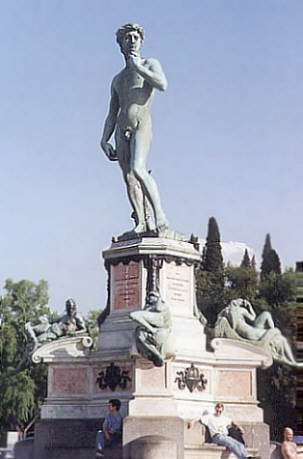
A few steps further we were on the Cross-Mountain. Some more
steps up and we passed San Salvatore. This small, brown Fransiscan
church was Michelangelo's favourite church but it is locked. We
had a break in a small park, meadows where families were having
picnics, sitting on a bench in the shade and enjoying the silence.
Down there the street noise is seething but here it's peaceful. A
monk was passing by. We followed until we stood in front of another
steep flight of stairs. High above throned San Miniato. There's
the legend that the beheaded martyr Minias (he suffered under
emperor Decius in 250 A.D.) had picked up his head and ran with
it up this steep hill (without the steps then). On the place
where he fell down dead was erected this church (finished about
1207). I admired the ancient thick Carrrara-marble plates with
intarsias of dark green serpentine of the facade, which was the
model for the baptistery for instance. High above the eagle of
the guild of Calimala perches, in its claws he has a bundle of
wool.
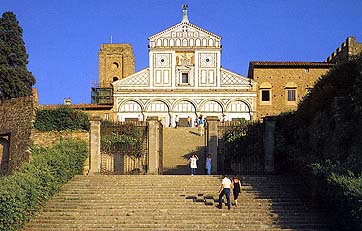
Inside you'd be startled by the darkness, but it's worthwhile to
have a look at the precious interior. It's lonely and quiet, but
outside of the church's coolness the sun glistened, flooding the
terrace. Tourists stood, looked and photographed the town beneath.
But we searched for the entrance to the cemetery.
Do you know Italian's cemeteries? It's a stone-desert, sorrow
turned to stone. Fascinating. Monumental steles, crosses, vases,
chiselled from stark white marble. The street is lined with family
chapels like a procession. You can enter them all, there are long
walls with coffins looking like drawers. Outside more bronze busts,
sad puttos and angels, ivy- and laurel garlands around pillars. It
seemed to be endless. But then I saw it: The death angel - a naked
Thanatos, his torch fallen to the ground, full of grief overthrown
a gravehill, his face burried into earth. I stood in awe for this
I've never seen before.
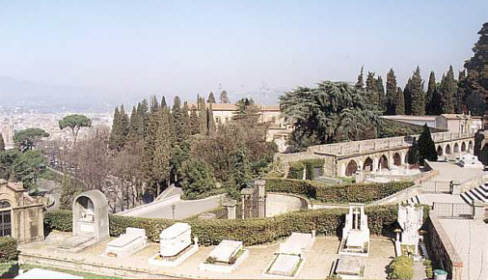
Behind the church still stands the brown clock tower. I told you
already about the fall of the republic of Florence in 1530. This
clock tower was an exponential aim for emperor Charles V, who stood
in front of Florence' gates just two years after his Sacco di Roma.
Michelangelo, just busy to work on San Lorenzo's New Sacristy,
joined the committee to protect the town. He erected the town walls
(still to be seen from here) around the hills, the town and down the
valley. And he had the idea to protect the clock tower with
matresses,
with straw- and wool bales. It worked out for the cannon balls
bounced off and fell to the ground without leaving damage. But
it didn't help, after eight months the town was starving. There
was food for just three days. The citizens considered seriously
to burn down their town, kill children and women and to destroy
themselves in an inferno before it would fall into the enemy's hand.
Finally Malatesta Bagliori - the hired condottiere of Perugia and
commander of Florence troops - betrayed the town, united with the
Spanish troops and opened the gates for Charles' army. The town
capitulated. He appointed the Medici-bastard Alessandro as sovereign
and gave him his daughter Margherita. Alessandro was the most hatred
Medici ever. He led a reign of terror. But the man behind them
was Baccio Valori, the governor, while Alessandro was just a puppet
in his hands. The execution starts, Michelangelo's friends are the first.
Even he was on Valori's list to be executed for he was under the
rebels.
The prior of San Lorenzo hid him in the clock tower of San
Niccolo where he spent several month in constant fear until
pope Clement VII intervened (perhaps I have to add here that
Clement fully accepted the fall of Florence and was even involved.
After all he straightened the way for his family to take control
again for Alessandro was his son). Clement wanted his friend back
for Michelangelo had to finish his work in
San Lorenzo, and so he was saved. A few months later he had to made
a work of art for Baccio Valori, the willing servant of the Pope and
the murderer of his friends. What could he do? It is the Apollino,
to be seen in the Palazzo Vecchio.
Alessandro himself was murdered soon by one of his relatives
Lorenzino.
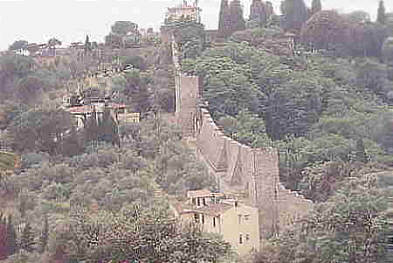
It is Sunday. What to see? There's so much a year wouldn't
be enough. Through the empty streets our way leds to Piazza Santissima
Annunziata. A place that belongs to the most beautiful in Florence
because of its ensemble of buildings. First there's Brunelleschi's
foundling house, a grey-white loggia with terracotta-medaillons,
two green, bizarre fountains and an equestrian statue of Duke
Francesco.
In the square took place a flower market. Geraniums over geraniums
and women standing
in long rows. It's Mother's Day, but what happens
here? And why do the women carry the flower pots into the church?
We follow them into the church Santissima Annunziata, passing the
covered cloister of the votive gifts. For hundreds of years pilgrims
have left their gifts here until they burst the room and they were
removed. But we are curious where the women are carrying their
flower pots.
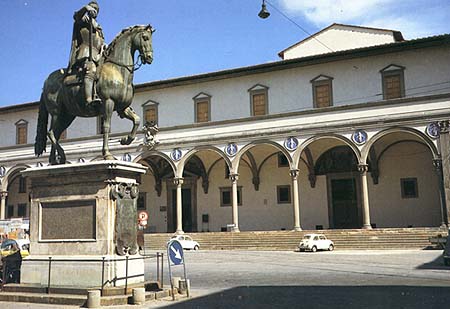
Baroque splendour meets us: grey, white and gold. The women set
up the pots in front of the
miraculous image of Virgin Mary. Of
course! It hangs in a gigantic tabernacle. So big the tabernacle,
so little the painting. The Madonna wears a real crown and a golden
necklace. We are dazzled. The altar gleams with pure silver, a
trellis of tied bronze ropes. From the ceiling hang countless burning
bronze lamps. Thick marble pillars surround it. According to the
inscription it cost 4.000 Florin, which was an enormous sum. The
place isn't big enough for all those red flower pots. The women
kneel in front of the trellis and pray ardently.
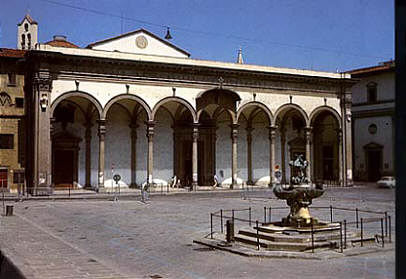
We came at a not very suitable time for the church is filling
for a mass. The servers are ringing already. Like everybody we
stand in front of the benches and listen to the priest's words.
He's preaching the paternoster I guess and the crowd answers. A
simple woman behind me prays loudly. We better go out. Somehow we
feel like intruders.
The door to the famous 'cloister of the dead' is locked, like
the entrance to the museum of San Marco. But if you've read my
story 'San Marco', you know this already. It is really a pity
for the former monastery is really worth a visit. There are the
touching freschi by Fra Angelico with which he painted the rooms
of his brothers. But the church is open and there happens what
I described in my story - well, not really. But I spoke to
Savonarola's monument half-aloud and had the feeling that he
was piercing my eyes.
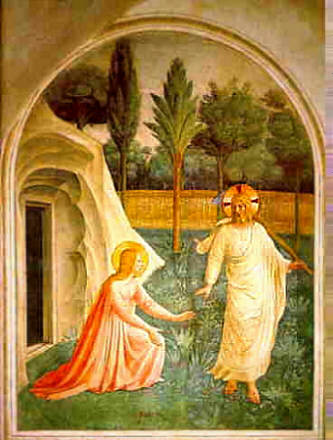
There's still time to visit the Bargello, a communal palace
built in 1250, later the place of the podesta (mayor). Even
later then the police captain had his domicile here. It has a
lovely yard (Foto) and a steps that leads to a great museum.
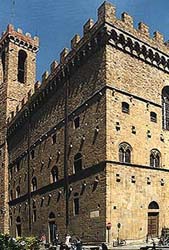
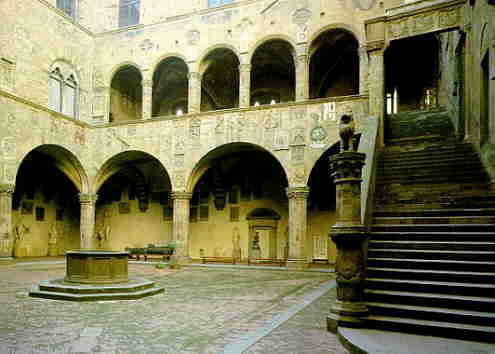
From 1502 on this yard was the execution place. The gallows
was right beside the well. There's Giambologna's Flying Mercury
to admire, the gleaming bronze cast of a fragile, dancing God,
hovering in the air. And there's Michelangelo's
Drunken Bacchus .
He chiselled him in Rome where he fled after Lorenzo's death
and the banning of the Medici. Back in Florence he had made a
Cupid he sold as antique putto to a cardinal in Rome. It was
the only trick he ever played, so he is forgiven. Of course the
cardinal found out but wasn't mad at him. Instead he gave him
work and for his patron Jacopo Galli he made then the Drunken
Bacchus, unsteady in his movements, the flesh soft and delicate,
the facial expression tipsy. With this he overcame the 'dry,
hard and sharp edged manner' of the middle ages as Vasari wrote.
Also there's his Tondo Pitti and the marble bust of Brutus
(Foto). According to Vasari it glorified Lorenzino de' Medici,
the acclaimed Florentine patriot who killed the tyrant Alessandro.
Murderers of tyrants are heroes? Well, perhaps....
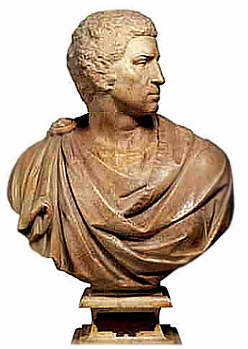
More?














